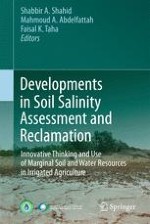2013 | OriginalPaper | Chapter
2. Soil Salinity Modeling, Approaches, and Key Issues
Author : Jorge Batlle-Sales
Published in: Developments in Soil Salinity Assessment and Reclamation
Publisher: Springer Netherlands
Activate our intelligent search to find suitable subject content or patents.
Select sections of text to find matching patents with Artificial Intelligence. powered by
Select sections of text to find additional relevant content using AI-assisted search. powered by
